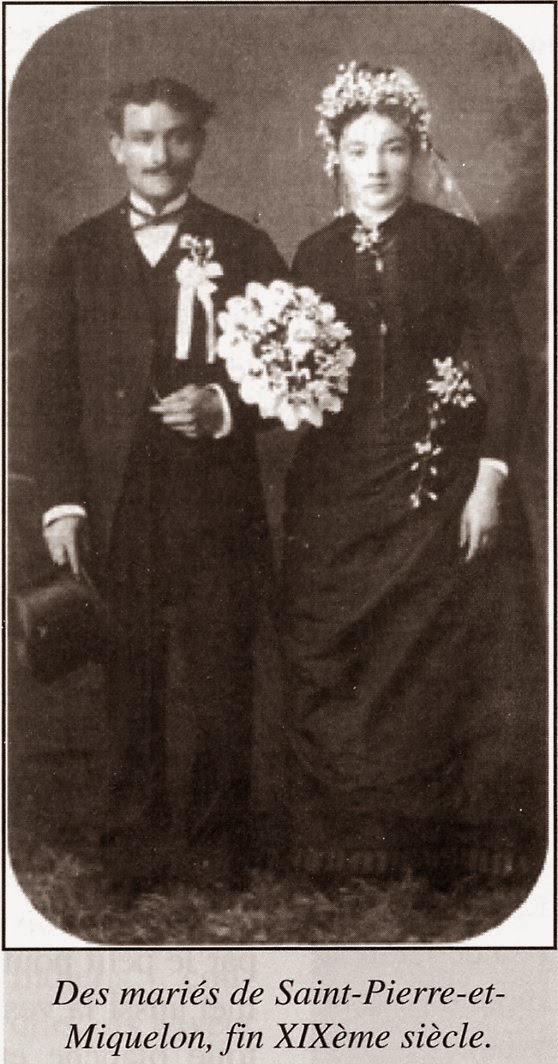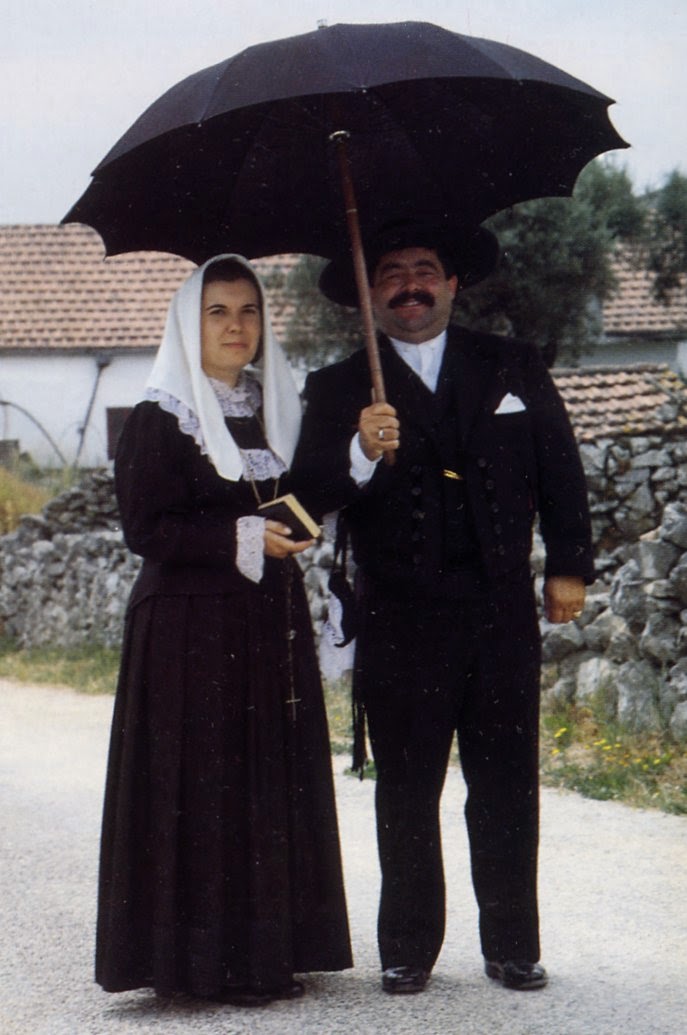Hello all,
In 1840, Queen Victoria decided to be married in a white gown, and thus started a fad which is still with us. She chose white because she had some lace that she was very fond of, and wanted to use it in her wedding. There was nothing traditional about it. There was at that time no tradition of being married in white. Portraits of the wedding, like the one above, were widely seen and her choice in fashion was copied. All the symbolism attributed to the white gown are later accretions.
People have, of course, always gotten dressed up for their weddings. Often the bride had spent years embroidering parts of her outfit, but generally it was a more colorful and elaborate version of the clothing she would wear on special occasions for all of her life. Very commonly traditional bridal dress incorporated flowers and a crown or wreath of some kind. There was no color considered to be specific for weddings; wedding dresses were often black, or red, but usually very colorful. They were rarely plain white. Also, while some elements, such as the crown, were reserved for weddings, most of the wedding outfit continued to be worn on special occasions. Queen Victoria could certainly afford to have a gown made for just the one occasion, but most people did not.
Many of the so called 'traditions' connected with modern western weddings are in fact recent innovations. Being of Ukrainian background, I find some of them bizarre, and very un-European, such as the veil, the sequestering of the bride from the groom on the day of the wedding, the giving away of the bride, all of which suggest more a middle-eastern mindset in which the woman is treated as chattel, rather than an egalitarian European one.
And of course, many of the 'traditions' are designed to sell things; after all, weddings are big business.
Here are some examples of Bridal outfits from around Europe which are truly traditional. If you have a strong connection to a particular ethnicity or place, I strongly urge you to research your background, and make your wedding more truly meaningful, rather than just another carbon copy of generic western culture. There ARE ways of doing things that do not involve dressing up like Queen Victoria.
Please enjoy the following selection, which, by the way, is far from exhaustive. There are many more.
I found so much material that I decided to only do a quick scan of western Europe.
Saami
A Saami bride borrows many silver brooches to wear on her silk shoulder scarf. A crown, as in other parts of Scandinavia, is also worn.
Norway
In Norway, crowns come in two forms. The more common is shaped like a stereotypical crown, like this very large example from Hardanger in Hordaland.
Here are other examples from Valdres;
and East Telemark, which also includes a special white apron and an embroidered cloth over that.
In Setesdal, the crown is shaped more like a tiara. Here they also have a special white apron with a colored silk one over it. The bridal outfit also includes a red frock worn over the normal white and black ones.
The second type of crown is flat, with silver dangles and is highly embroidered or beaded. This type is found in Voss
and in West Telemark
There are, of course, many other local variations.
Sweden
Skåne
A very common bridal accessory is a wreath or crown of imitation or real flowers, here made of colored feathers.
Rättvik, Dalarna
She is wearing both a small crown and a flower cap. He is wearing a lace collar which is not part of the typical man's dress outfit.
Leksand, Dalarna
notice that here the flower wreath is around the shoulders rather than on the head.
Södermanland
Sometimes, as here, the crown is quite small, although it retains the full symbolic meaning.
 | |
Värmland
The base of the crown is here hidden by the flowers.
Finland
Wedding in Jomala
Denmark
Wedding in Fanø
Germany
Das Altes Land
The bride is on the right, with the flowers and wings on her cap.
Miesbach, Bavaria
This is the same outfit she would wear on any festive or ceremonial occasion.
Calwer Waldt
Colored blown glass balls are a common feature of German wedding crowns. These are made in the same way as Christmas tree ornaments.
Marburg
A wreath of flowers on the head, and also around the arm.
Scheessel
The bridesmaids as well as the bride wear high crowns decorated with colored blown glass balls and other features. The bride also has a white lace fichu and a white apron.
Bad Nenndorf
Gutach, Schwarzwald
The bride is on the left. The basket shaped crown is typical for southwest Germany and parts of Austria
France
Savoie
The bride and groom are marked here by the boutonnieres with ribbons attached. This is found in many other places in Europe as well.
St. Pierre and Miquelon
Upper Savoy
Alsace
Also in Alsace, a bridal couple from Seebach or Oberseebach. The groom wears a posy in his hat and a boutenniere with ribbons. The bride wears a crown and armbands with flowers and silk ribbons.
Normandy
French Flanders
Provence
Minho
Douro
Beira
Algarve
Estremadura
Laguartera
Burgos
Salamanca
Toledo
Valencia
Scanno, Abruzzo
Arbereshe
Sardinia
In the south of Sardinia, a traditional part of the wedding is the 'chaining' of the bride and groom.
Austria
Here is an example of a modern style formal Austrian dirndle considered to be appropriate for a wedding.
I hope that you have found this interesting.
rkozakand@aol.com
Source Material:
Debionne/Meissner, 'Die Schoensten Deutschen Trachten', Munich, 1987
Gisela Wulff, 'Luettje Burdeern von'n Doerpen', Germany, 1979
Tomaz Ribas, 'O Trajo Regional em Portugal', Braga, Portugal, 2004
Heidi Fossnes, 'Norges Bunader og Samiske Folkedrakter', Oslo, 1994
Laila Duran, 'Scandinavian Folklore vol I - III', Sweden, 2013
Caroline Brancq, 'Les Costume Regionaux d'Autrefois', Paris, 2003
Rode de Basso Prouvenco, 'Le Costume Populaire Provencal',
Radost Ivanova, 'Traditional Bulgarian Wedding', Sofia, 1987
M. Veleva, 'Bulgarski Narodni Nosii vol 1 - 4', Sofia,





























































